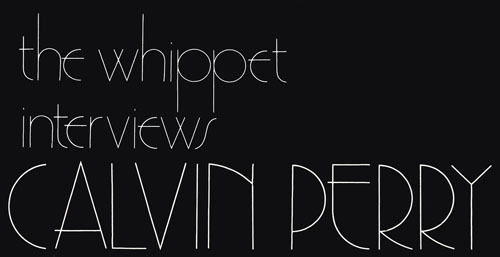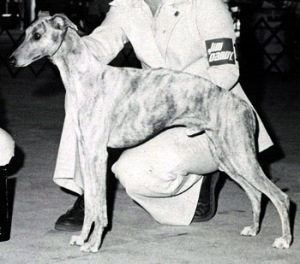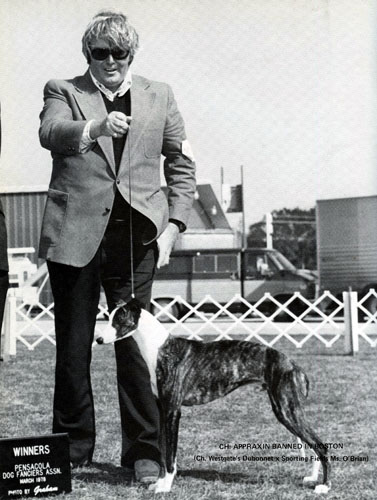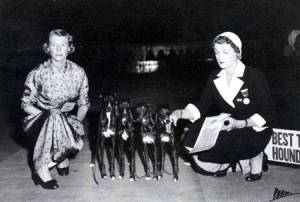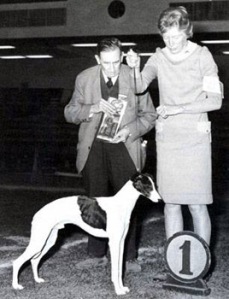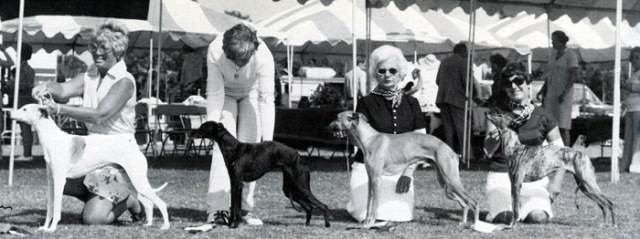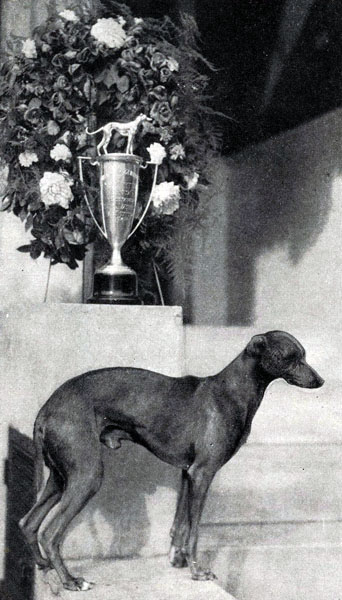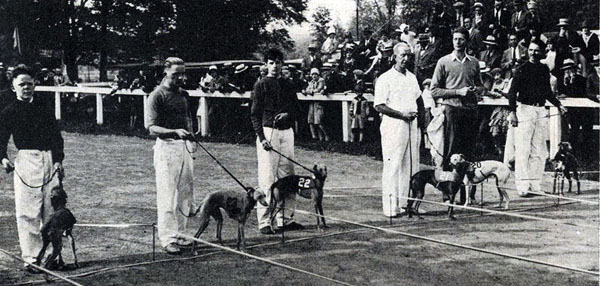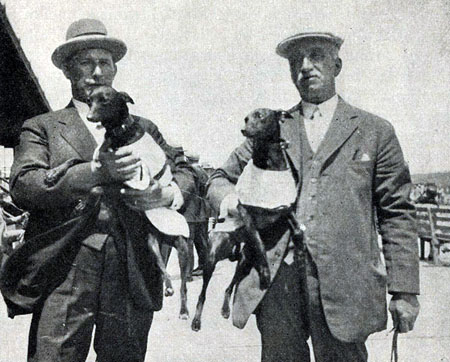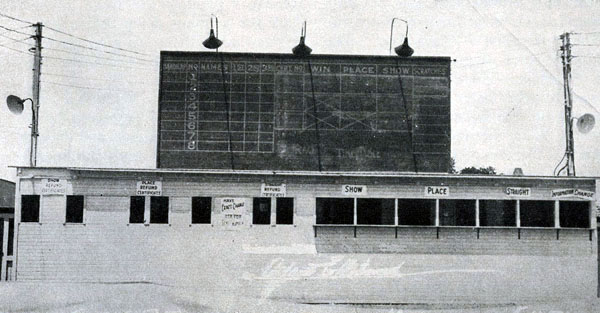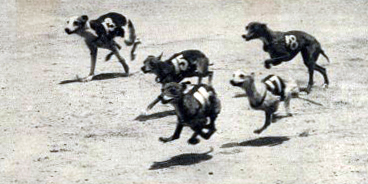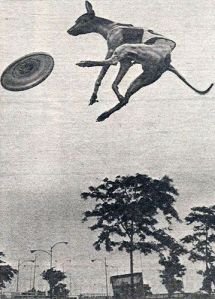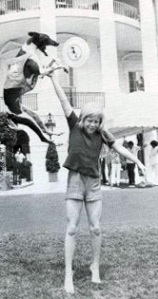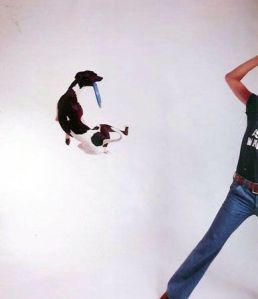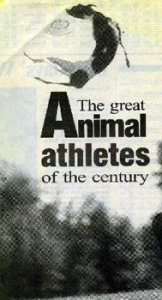The 2011 AWC Southern Specialty will honor Cal Perry this year. Here is a copy of the artwork done by Yvonne Sovereign which will appear on the plates for the winners and a great article from 1979 with Calvin interviewed by the Whippet Magazine.
“Reprinted from The Whippet Magazine, by permission of the editor of the Whippet Magazine”
Whippet: How long have you been involved in purebred dogs?
Perry: Well let’s see. I have been attending dog shows all my life. When I was about 12 years old I used to pay my older brother to take me to dog shows. It cost me a fortune. He used to wait 3 or 4 hours for me. I used to go especially to see the Afghans because at that time, which would have been in the early 50’s, Afghans were very exotic and down here in Florida we had only seen five or six per show. Mostly specials. They were very different in type, but they were very glamorous and exotic and it was really one of the rare breeds at the time, if you can believe it. And there would be two or three local dogs that were badly in need of grooming, and then these lovely specials of varying types.
I don’t recall ever seeing a Whippet until about the summer of 1952 which was the year that I finished with high school and I was at Harvard summer school and this young couple used to come in and exercise their very large fawn Whippet, I believe a bitch, in the Harvard yard. I thought it was the funniest looking dog I had ever seen. I had been very interested in Greyhounds before this growing up in St. Petersburg, Florida where the worlds oldest Greyhound track is located. We used to go watch them train and so forth and I had friends that had pet race Greyhounds that had been rejects from the track. I used to go visit one particular girl and take her dog to the beach. I didn’t really go to see the girl, I went to see her dog. We had this mad affair going (the dog and I) and this is really how my interest in sighthounds got started. So, this is why I am not opposed to people who get interested in sighthounds through race dogs because you have to be stimulated in some way and this is as good a way to get started or interested in sighthounds as any other, I think.
Whippet: Did you have any other dogs?
Perry: I have had other breeds, yes, IG’s, Borzoi, Afghans, Japanese Chow, Smooth Fox Terriers and even a Bedlington champion. I think when I first started looking for show dogs very seriously I was looking for a Greyhound. And at the time I really could find none, I knew of Elsie Neustadt, but she had nothing for sale. So really as a second choice I fell in love with a Whippet called Ch. Whipoo’s Spatarib of Meander. He was a dog that Meander had bred that the Jacobs in Illinois had so I went to visit them for a weekend and bought one of his daughters and that was my first Whippet who turned out to be Ch. Whipoo’s White Lustre.
Whippet: What were her bloodlines?
Perry: She was by the Spatarib dog who was a Bob White son out of one of the Whippet bitches which I think was half meander, a quarter Stoney Meadows and a quarter Pennyworth. I used to be better at pedigrees than I am now.
Whippet. Was that the beginning of Appraxin?
Perry: Not really. I was already in to Borzoi and my first Borzoi was Trezur Appraxin that I got from Russell Everhart in Ann Arbor, Michigan. The dog went to about three shows and did very well and then contracted some rare disease and died. But I kept the kennel name Appraxin from. my Borzoi, as the kennel name for my Whippets. I never did have a litter of Borzoi. I tried.
The first Whippet I got was in about 1957, the Whipoo’s White Lustre from the Jacobs. She finished fairly easily that same year, later in the year I got Meander Town Topics from the Shearer sisters in Virginia. This dog was very near and dear to me, even more than the bitch. He had fourteen points in a very short time, and the week before he might have finished he was hit by a car. I lived way out in the woods, but somehow the dog was chasing another dog and got run over. It was very tragic and I was very upset about it. But later I went back to Meander and got another dog and so forth so my basic start was through this Meander dog and Whipoo bitch.
Whippet: What was the first litter you bred?
Perry: The first litter that I had would have probably been about 1960. I bred Whipoo’s White Lustre to Ch. Stoney Meadows Red Fox. I finished one out of that litter who is Ch. Appraxin Reynard. He was the first champion that I had bred. His brother, Appraxin Snow Fox, CD, appears in some of my dogs pedigrees way way back even now through a dog that I acquired in the last few years Ch. Westgate’s DuBonnet who I got from Ann Wonson in Massachusetts. Also in 1959 or 1960, Doris Wear of Stoney Meadows fame gave me Ch. Stoney Meadows Sprint who won our National Specialty in 1960 and was a BIS winner in Canada and a Group winner in the states and had probably more best of breeds for a year or two than anyone else, mostly because I showed a great deal at that time. I was young and enthusiastic. He is still behind one of my brood bitches that I have that I got from Melody Howarth Gomes up in Rhode Island. It is interesting that a lot of our dogs don’t show Appraxin on either parent, but they go directly back to Appraxin breeding. And it is sort of the old story that other people have more of my own bloodlines than I do, lots of time, because I have sold dogs or placed dogs or have dogs out on terms. You see Appraxin in your pedigrees but it is not necessarily right up front.
Basically my breeding program stems from the brood bitch, Ch. Pennyworth Highstyle, who was a Courtney Fleet Foot daughter out of a Fleeting Falcon bitch. This bitch bred to my second Meander dog, Meander Shake Down, who proved very valuable for a stud dog produced Ch. Appraxin Mind Duster who we call Junior. He has been a very successful stud. He has produced several very good champions. Several group winners and I have liked the stuff that he has produced overall. They need certain improvements, but overall he’s probably been the best producer I have had.
During all of this time, starting about 12 years ago, Dianne Horton Bleecker (Morshor) and I have been in somewhat of a partnership and we have either been very close neighbors or under the same roof for alot of this time and our dogs overlap a great deal. Of course, her basic line is Stoney Meadows combined with Highlight which are Mrs. Hodges dogs, especially through Whirlaway who was a inbred Barn Dance son. So we have had a lot of Barn Dance breeding with an infusion of Stoney Meadows again through the famous bitch Stoney Meadows Imp of Satan. Another dog that I think has contributed to my dogs is a Mardormere dog that I was very lucky to get. Skyrocket of Mardormere. I got him when he was about 9 or 10 years old and he was just a beautiful, very stylized typy dog (with faults) and he was very extreme. But we used him a couple of times. He was very hard to breed. We had a lot of fun outcrossing to him. He is behind some of my stuff too and we got some really outstanding heads and gorgeous bodies and lost a lot of movement with some of his progeny. He did have one very good son who was very sound too that the Bruce Bell’s in Massachutts have, Ch. Kapene Hemi who I think would be a very valuable stud dog if anyone would use him. He was bred by Dianne Bleecker and Barbara Collins of Florida.
Going back more to the earlier years, I never had a great deal of success in the first few years of actually breeding. We finished dogs, but lots of time they were only finished because we tried so hard to finish them. Sprint was never a great producer. He had two very good daughters out of a Pennyworth bitch, Ch. Black Orchid that Peggy Newcombe bred. But my bitches weren’t the right type for the dog. I had smaller bitches and this dog needed larger bitches. So really he wasn’t a huge success as a breeding animal, but he appears in some pedigrees and I loved him.
In the last 12 years we have had great success finishing the Whirlaway children. I think we finished 5 from a litter out of a Courtney Fleet Foot daughter, Ch. Pennyworth Golden Glory, of Peggy Newcombe’s breeding. Whirlaway combined well with the Meander line too. We took some of the bitches back like Whirlaway daughters or grandchildren back to the Meander Shakedown or the Mind Duster dogs. This brought in pigmentation, color, soundness, size and length of leg and so forth. It was combining the houndiness of the American type and the soundness of the American type with some of the style and quality of the English ones. That is what we have tried bascially to do. I think.
It is interesting that a dog I acquired after he was grown and partially finished, Ch. Westgate DuBonnet has had a recent influence on my breeding. He is a half brother to one of Cora Miller’s first basic dogs her Flying Machine, a lovely red dog. I suppose when you get back into the pedigrees of a lot of people that started around the same time, they are, of course, quite similar. Different individuals but the basic bloodlines being the same.
Whippet: Who was a contemporary of yours that started around the same time that you did?
Perry: Exactly at the same time was Janet Koch who lived in Massachusetts and later moved to Florida and who has recently passed away, Sheldegren Whippets. Joan Bartlett in Massachusetts started much the same time that I did. I am sure that alot of the California people did too. I don’t know the exact years, but I am sure that a lot of us started at pretty much the same time in the late 1950’s.
Whippet: In what features do your dogs excell?
Perry: Well, they are very loveable! Seriously, I like to have very sound, houndy, dogs. I like long tallish dogs. Very much in the order of a Greyhound in miniature as opposed to a shorter dumpier dog. I like soundness and elegance. Style and type all together. It is very important in our area to have soundness because we have so many all-rounder judging that without a sound dog it is much harder to win. Frankly, I like to pick a dog on type because without type what do you have? Not much! But if you can have both soundness and type, of course, you’ve got it all! We try to have lovely colors. I like the darker colors – brindles, orange brindle is probably my favorite color. I like dark pigmentation. I am a stickler on front movement. I don’t own a dog and haven’t for a number of years that didn’t move properly and really well in front. They must reach! It just can’t abide anything that even suggests hackney. I also don’t like bad ears and I try very hard not to have them. You get them very occasionally, but we don’t keep anything that doesn’t have a correct ear.
Whippet: Mrs. Doris Wear mentions in “The Breeders Forum” that she feels the East Coast badly needs more breeder-judging. She feels the Pacific Coast is much more fortunate in this regard. Do you feel this way?
Perry: I am very much for breeder-judges. I think that we in the South get almost no breeder-judges. I feel that a knowledgeable breeder judge is the epitome of good judging. I think that all-rounders are very important and maybe keep us interested in breeding sound dogs, showy and eye catching dogs, but it is your breeders who help you cement type and reward “the look” which is the Whippet. Hopefully it would be a ‘purist looking at your product, I mean that their opinion would mean a great deal more than the average all-rounders opinion. Some all-rounders have been excellent Whippet judges, Alva Rosenberg and Winnie Heckman. There are several that are superior and certainly on a par with your best breeder-judges. Overall, I would prefer to show under a breeder anytime.
Whippet: How many litters do you breed a year?
Perry: Well, up until the past four or five years we probably have had 3 to 5 litters a year. Now we are down to one or two. One is really enough.
Whippet: When do you grade your litters? Do you have any color preference?

Calvin Perry judging. Stoney Meadows Queen's Flight (Ch. Stoney Meadows Royal Flight x Stoney Meadows Flighty Queen), winning BlSweeps at the A.W.C. Eastern Specialty — September 10, 1978.
Perry: I think you can evaluate them somewhat starting at eight weeks, but I am so often wrong and I am very impatient and get rid of all the wrong ones so I am really not a good person to ask. Ideally you should keep them until they are 10 months to a year old, because you are much more apt to end up with what you really like. It is hard to keep that many that long and it’s not really fair to the dogs. It’s better to get them out even if you make an occasional mistake. Some of our most successful dogs have been dogs that we have let go early that people have made a great deal out of or have done alot with them which, you know, if they had lived with us until they were a year old they might not have been quite as charming and successful later. I prefer the darker colors, the deep colors, the brindles. I try to like white and brindle because that is all we get. I like fawns and reds very much but we almost never see them. Color is of secondary importance — for sure!!
Whippet: How many dogs do you keep in your kennel?
Perry: We have about 10 or 12 adults and usually a litter on the grounds and maybe a teenager or two also who must live in the house.
Whippet: How do you feel about culling?
Perry: It is very necessary I think. I have been very lucky in the last four or five years in placing dogs. I work in a large office and can often place them rather well. But, I much prefer putting one to sleep than placing it indiscriminately and especially a bitch. I think we have to practice euthanasia but hoepfully not very often anymore. Whippets are fabulous pets!
Whippet: At what age do you start showing your dogs?
Perry: We usually get a puppy out a few times when it is very young. And sometimes they finish from the puppy class or come very close to it. Some dogs just don’t catch on until they are a year and a half or more. We try to take them to matches alot when they are babies. I start my dogs out when they are pretty young, but I don’t put them in Open. Either in Puppy or Bred By class until they are well over a year old.
Whippet: How is the Whippet interest in Florida? Has the Whippet population grown?

Left: CH. APPRAXIN MIND DUSTER (Ch. Meander Shakedown x Ch. Pennyworth High Style) and Right: CH. MORSHOR'S MISCHIEVOUS IMP (Ch. Pennyworth Would You Believe x Ch. Stoney Meadows Imp of Satan)
Perry: I started showing in Florida about 15 years ago after showing in the New England area for 4 years previously. When I started sometimes there would be no other Whippets. Sometimes Janet Koch would have a special or a class dog and then Reagan Meadows from Columbus, Georgia with Jaduli Whippets would appear and he often had a special shown or a special of his breeding would be shown. So, really for the first 3 or 4 years in the sport in Florida we were the only three showing at all. Then through the years Peggy Newcombe moved here with her Pennyworth Kennels, Dianne Horton Bleecker moved here with. Morshor all in a very close area. Barbara Collins started breeding. Elaine Usherson breeding some very nice Whippets in south Florida and the Miami area. The Stan Wilson’s moved to Florida with Flippet Whippets so we really had a hot bed of Whippets and then in the January shows we were very honored with Cora Miller coming down and Doris Wear and we get alot of the biggies down here and have a lot of fun. The Butts winter in Florida and add to the excitement and quality. We have very good entries. Most of our shows are major shows. We don’t have to have quite as many to make a major as they do on the West Coast, thank goodness! Some of the Spring and Fall shows are smaller but almost every show is at least two or three points.
Whippet: Do you have much problem with heartworm in this area? And how do you fight it?
Perry: Oh yes, we have to give Sterid Carorcide from the first meal of the puppies for the rest of their lives. So it is no problem because we medicate every day.
Whippet: Do you race or course or participate in any obedience?
Perry: I have never been into obedience but we do course and do have two coursing champions who are also Group winners.
Whippet: Is coursing pretty popular in Florida?
Perry: Yes, I think so. It is fun to do on Sunday afternoons.
Whippet: Now let’s talk about Monorchidism.
Perry: I have gone for three years with a litter or two each year and have not had one monorchid or cryptorchid and then in one year maybe raise one male puppy that is complete. They are all basically the same breeding or even sometimes the same dogs so it is just such a fluky thing. We just laugh and say it is something in the water. But it is a problem in the breed. I don’t know how we will ever get over it. It is one reason to cull. It is heartbreaking because very often your best puppies are monorchids.
Whippet: What do you think about the recent survey that was sent out allowing neutered and spayed dogs to race?
Perry: I am not familiar with the survey, but I think letting them race is a good idea. It gives them something to do. It keeps them off the streets.
Whippet: How would you say the Whippet has improved or regressed over the years?
Perry: Oh, I think, that there has been real improvement. There are far more attractive Whippets than there used to be. Individual specimens are very outstanding in the past but there has been a great improvement overall. There is a great deal more elegance in head and neck. Much more uniformity in size. I think that a great deal of that has to do with the Barn Dance, Whirlaway progeny who were among the first stud dogs you could breed to and get any consistency in your litters. Before you would get great big ones and real small ones all in the same litter. I think that there is much more consistency as to size and type than there used to be.
Whippet: What do you feel is the worse problem in the breed today?
Perry: Walter Wheeler in Massachusetts has always said this and I completely agree with him. The trademark of the Whippet is their topline. Many of our dogs have lost it. We are getting table tops or sloping tops like Shepherds and I think that this is a very serious fault because if you saw a Whippet at a distance the identifiable trademark is their outline. And, I think, Whippets should have a nice natural arch and definitely not a flat back or a sloping topline.
Whippet: There has been a lot of controversy about the topline. Would you describe what you feel is correct.
Perry: Well, it is really to describe what isn’t correct actually. A topline with a dip or a completely level topline is wrong. I like a very natural arch (people immediately think when you say arch they think of the McDonald’s arch). I would almost like to have too much rather than not enough because I like a rather stylized animal. But, of course, this is contradictory to having your long lean hound. I think that there is a correct, happy median. The Whippet should be level and smooth across the shoulders going back into a slight moderate rise and then falling away over the loin with great follow through of rear — good rear angulation. If you have a very short angulated dog behind, it is going to give him a slapped ass look. Or the dumpy look, or a shorter look. If you have great rear angulation and follow through it’s going to balance your dog out with the correct topline I’m hoping we’ll have.
Whippet: How do you think that the breeders are doing today? Do you have a favorite?
Perry: Well, I think that the competition is much stronger than it has ever been before. I think that there are some lovely dogs around. Doris Wear would certainly come first to mind as a great breeder. She has had some beautiful animals right on through the years. And her stock has contributed a great deal to everyone elses or at least to a lot of the successful American breeders. Also Mrs. Peggy Hodge with Highlight Whippets. Her breeding has contributed a great deal to others and the perfection of others’ breeding programs and dogs. I think that both of them have been very valuable contributors to our breed and deserve our graditude.
Whippet: Do you breed dogs to satisfy yourself or the judges?
Perry: Well hopeful! both but, I am an egotist and I try to please myself first and hope that some judges will like them. (Let’s all read the Standard together, Amen!)
Whippet: What is your opinion on breeder-judges who exhibit?
Perry: Well, unless you are infirmed or dying of old age, I think naturally your interest is going to continue in breeding and owning dogs and just because you judge isn’t going to make you a bad breeder and just because you breed isn’t going to make you a bad judge. Hopefully the two would be complimentary. I think that you could certainly do both.
Whippet: Are you an AKC licensed judge?
Perry: No.
Whippet: You recently judged the Eastern Specialty Sweepstakes. Would you like to tell us something about it?
Perry: Yes, I enjoyed it very much. It was at Westchester which is a beautiful fabulous show. The weather was fantastic. I was very thrilled. Some of the dogs were just outstanding. I remember especially the adult bitch class (I think we had 18). There were at least six that were just wonderful and you know only have four placements, but there were at least six that I liked very very much and they were high class. I though, overall the movement was quite good. The front movement was pretty good on almost all of them. A few of the rears were weak. I think that alot of people don’t run their dogs enough and I don’t think that it is necessarily bad breeding, it’s lack of conditioning. Maybe the dogs aren’t free to run as much as mine are and other peoples dogs that have really strong rears. Probably a lot has to do with weather and the way dogs are raised in the North where they don’t run growing up as much as they could. One fault that did disturb me were heads that seem to be to large for the dog. There were a few that were not only heavy headed (what we might have called bucket heads in the old days) they had very long snouts but they were not balanced properly and the eyes seemed to be small and set in the snout almost. They were very strange heads and I found very untypical of the breed. A few of these that had this type of head also had very yellow eyes. This is one criticism that I had of some of the dogs. Some of the others had just gorgeous heads and were very typy.
Whippet: Are you a member of the American Whippet Club?
Perry: No, I was for a number of years and was Secretary for four years but I have so many other obligations that I just wasn’t really free enough to contribute when I was a member. But I love to go to their specialities.
Whippet: Do you feel that there is more quality in dogs than in bitches or bitches rather than dogs?
Perry: Well, in Florida right now, there is much better quality in the dog classes than in the bitch classes. The bitches are amasingly weak right now, but in previous years the bitches historically in Whippets have been superior to dogs and often our top specials have been bitches.
Whippet: What do you think of only having three specialty shows?
Perry: Well, specialty shows are a lot of work and they should be special. I think that probably three are enough. Different areas can have any number of sponsored shows if they like and these have a lot of the interest of a regular specialty. I think probably keeping it at three keeps the value of the specialty high. We don’t want specialties every other weekend I don’t think.
Whippet: You have been to all of the specialties. Which one is your favorite?
Perry: Well, I am more concerned with the Eastern Specialty and I suppose it is sort of the mother specialty, but all of them are very outstanding. I have enjoyed them all very much.
Whippet: Do you think that there is a lot of politics on the breed level?
Perry: It’s hard to say what is political and what is just poor judging. Life is made up of spheres of influence and I think we just have to contend with that in dog shows, it is just one of the facts of life. I don’t think that it is particularly noticeable – politics that is.
Whippet: What area of the country has the best Whippets in your opinion?
Perry: There are outstanding dogs in every part of the country. The East has always felt that they were way ahead and maybe they were in the past. But, I think, that California has come a long way in the past few years. There have been some lovely dogs from California. The East isn’t doing badly, either.
Whippet: Do you think that there is a difference in size in different parts of the country?
Perry: There is a difference in size everywhere. I think that possibly in Florida our dogs are pretty uniform. But, you know that there is a big variation allowed in the standard so I don’t think that it is particularly alarming. I just think there are all sizes everywhere.
Whippet: Is there anything in the Whippet standard that you would change?
Perry: The one thing that has always bothered me about the standard is that I don’t think that the ears are adequately described. It says semi-prick ears. Semi-prick ears are like Collie ears. I think we should describe it as a Rose ear as it is described in the Bull Dog standard. I think that it would be much clearer to everyone if we demanded a Rose ear.
I think that there is alot of confusion about feet. The standard calling for a hare foot as opposed to a cat foot which would be a rounder foot. I find a cat foot more aesthetically pleasing. I think that they all can run, but I think that most judges and me as one breeder prefer a foot that may not be described adequately in the standard – a different type of foot than is described in the standard.
Whippet: Would you name some Whippets that you feel in your opinion are great?
Perry: Well, I think that Doris Wear described it perfectly in the last THE WHIPPET. It is and has always been Winterfold Bold Bid. She would be the one I would remember if I could only remember one Whippet. Another one that I like very much that goes way back would be Ch. Stoney Meadows Snow Queen who was behind a lot of Doris’ breeding and was a terribly attractive, lovely animal. And, of course, I always loved very much Ch. Pennyworth’s Merri Xmas that I got from Peggy Newcombe.
Whippet: Do you think that dog shows are like they should be fun?
Perry: I think that dog shows are still fun, or we would stop going. When you start out they are probably more fun, but it is just because you are new and everything is more fun when you are younger. I still enjoy it very much.
Whippet: Are there any other sides of you like artistic, hobbies or crafts?
Perry: I wish I could give you a substantive answer, but Whippets have always been the consuming passion of my life and I really haven’t had a lot of energy for much of anything else, except making a living.
Whippet: Could you summarize your outlook on the breed today?
Perry: I think that the breed is in very good shape. I think that it is reflected by the fact that Whippets do very well in Group and BIS competition. There are alot of people doing some very interesting and good breeding. I think that one of the most important aspects of Whippets is that it has attracted a very interesting group of people. Really, when you get down to it the best thing about showing and exhibiting and having Whippets are the people you meet and it opens whole new worlds for you. The dogs are important and we enjoy them very much, but I think that the people in Whippets are really what keep me in it. Besides, what else would I do on weekends?


